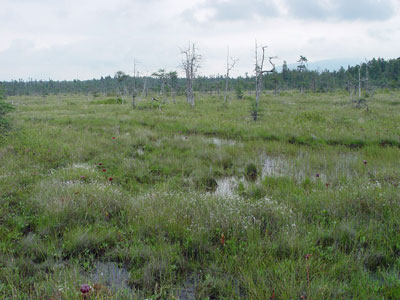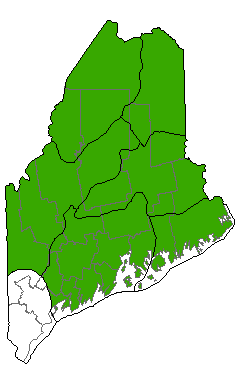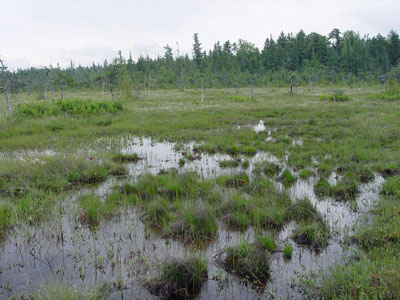DACF Home → Bureaus & Programs → Maine Natural Areas Program → Communities, Plants, and Animals → Natural Community Fact Sheets → Low Sedge Fen
Printer Friendly Fact Sheet - 840 KB pdf (Get a free copy of Adobe Acrobat Reader)
Low Sedge Fen
Scientific Name: Low Sedge - Buckbean Fen Lawn; State Rank: S3

- Community Description
- Soil and Site Characteristics
- Diagnostics
- Similar Types
- Conservation, Wildlife and Management Considerations
- Distribution
- Characteristic Plants
- Associated Rare Plants
- Associated Rare Animals
- Examples on Conservation Lands You Can Visit
Community Description: This type is characterized by peatland vegetation dominated by low mats of sedges (typically 40-60% cover), sometimes with sparse low heaths, over a continuous and very wet peat moss substrate. White beak-rush, mud sedge, and few-seeded sedge are usually dominant. Podgrass and buckbean are particularly characteristic, and sundews and horned bladderwort are typical in openings among the sedges. Heath shrubs are sparse; the most frequent are leatherleaf or bog rosemary, with other heaths on scattered hummocks. Bog-mat liverwort is an indicator species, although it is not present in all examples of this community type. Back to top.
Soil and Site Characteristics: This community occurs in very wet portions of peatlands but not in raised portions nor adjacent to open water. It occasionally occurs in mineral soil marshes that grade into peatland areas. The substrate is constantly saturated, often unstable, and acidic (pH 4.0-5.0). Back to top.
Diagnostics: In a peatland, graminoids are dominant over a well developed bryoid layer. White beak-rush, mud sedge, and occasionally few-seeded sedge are the dominant sedges. Dwarf shrubs form less than 20% cover and the substrate is saturated to the surface. Back to top.
Similar Types: Sedge - Heath Fens are closely related but have more leatherleaf (usually > 25%) and often have coast sedge as a characteristic species. Leatherleaf Bogs are shrub dominated, rather than sedge dominated. Circumneutral Fens are also typically graminoid dominated but by different sedges, and will have the characteristic calciphilic species that are generally absent from this type. Tall Sedge Fens feature taller and denser graminoids and usually have abundant slender sedge. Back to top.
Conservation, Wildlife and Management Considerations: This community type is not particularly common, but it has been subject to few threats to date. Some examples occur on public lands and private conservation lands. Impoundment or draining would have negative impacts on hydrology and on vegetation. Slow vegetation growth rates, due to the nutrient poor environment, result in slow recovery from physical disturbances. Degradation from recreational use is unlikely, because of the unstable substrate; but if disturbance, such as foot traffic, is a necessity, traversing during frozen conditions or using boardwalks can minimize impacts.
Several uncommon dragonfly species may be found where bog pools and seasonally inundated depressions occur, including the zigzag darner, subarctic darner, and incurvate emerald. Occurrences in northern Maine may be inhabited by the subarctic bluet, an uncommon damselfly that inhabits open marshes and fens and reaches the southern edge of its range in northern Maine. The delicate emerald, a dragonfly that inhabits bogs and fens covered with a carpet of low sedges, is also a likely associate, as is the rare Quebec emerald. Back to top.
Distribution: Northern and eastern Maine (New England Adirondack and Laurentian Mixed Forest Provinces), presumably extending into Canada. Landscape Pattern: Small Patch. Back to top.


Characteristic Plants: These plants are frequently found in this community type. Those with an asterisk are often diagnostic of this community.
- Sapling/shrub
- Speckled alder
- Dwarf Shrub
- Bog rosemary
- Labrador tea
- Leatherleaf
- Rhodora
- Small cranberry
- Herb
- Bog goldenrod
- Buckbean*
- Mud sedge*
- Pitcher plant
- Podgrass*
- Round-leaved sundew
- Tawny cotton-grass
- Three-leaved false Solomon's seal
- White beak-rush*
- Bryoid
- Sphagnum mosses*
- Quebec emerald
Examples on Conservation Lands You Can Visit
| Example | County |
|---|---|
| Marble Fen Preserve | Penobscot Co. |
| St. John River Preserve | Aroostook Co. |
| Telos Lake Public Lands Unit | Piscataquis Co. |
